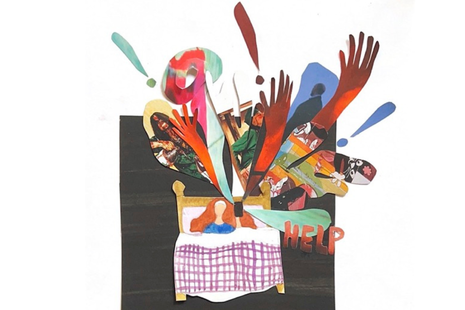So much doom(scrolling)
Matthew Taylor dives into our relationship with social media and the digital world

It is a truth universally acknowledged, that a student in possession of a smartphone, must be in want of a way not to pick it up when studying. But it’s not our fault if we fail – it’s an addiction, we say, and even the language we use seems to concur. When it comes to the digital world we do not understand ourselves to have agency: we speak of being ‘chronically online’; our attention is ‘harvested’; and we are not just friends, not even just followers, no, we are ‘influenced’. But the digital world is also good. Really good. And I’m not just referring to the sweet rush of stumbling upon a video in which Kamala Harris has been superimposed onto Chappell Roan’s album cover with an accompanying mashup of Good Luck, Babe! and the coconut-context soundbite. Negative aura if you know what I mean.
“This is an issue our generation is disproportionately afflicted by”
The relationship between addiction and social media is more than just anecdotal, it is the subject of a wealth of research. Using traditional criteria for the study of addictions (which include the use of an addictive substance to reduce negative feelings, there being distress associated with withdrawal from it, and users experiencing an inability to control not using it), it has been suggested that more than 210 million people globally are addicted to social media. This is far from a minor problem. Attempts to understand who is affected most have identified that it is primarily age and sex that can predict social media addiction. This is, in other words, an issue our generation is disproportionately afflicted by. Perhaps our parents were right - it was the damn phones and we are all now suffering because of it. Perhaps that is a little dramatic.
But this is a problem we are taking seriously. One ironic solution that seems to have emerged organically in response to an increased awareness around our unhealthy relationship with social media is further short form content designed to be a break from the… short form content. Over the past year, my home pages have been overwhelmed by people directing me to breathe, to live slowly (whatever that means), to undertake a dopamine detox and in the past few weeks, I have seen adverts encouraging consumers to purchase a brick, so that they may lock their phone into only having necessary apps on it. The way to unlock it and access the apps you choose to ban? Tap the brick. The idea is to leave it at home and your phone becomes distraction-free as you go about your day. Curious. That will also be fifty dollars, by the way.
“At its core, the problem seems to be one of overstimulation and social media is just a single part of the puzzle”
It seems that such suggestions might not be so left field. Internet addiction, of which social media is one of many subtypes, is indeed “characterised by an impairment of the metabolism of dopamine” among other neurotransmitters, according to one 2023 paper published in the World Journal of Psychiatry. Anna Lembke, Chief of the Stanford Addiction Medicine Dual Diagnosis Clinic at Stanford, has herself suggested that locking our phones away for at least 24 hours is a productive way of resetting an unhealthy relationship with social media. Unlike the creators trying to convince you to undertake a dopamine detox on Instagram or TikTok via a colourful 15 second video of all you are missing when you scroll, however, Lembke doesn’t sugarcoat things: time away isn’t supposed to be easy. “We’ve lost the ability to tolerate even minor forms of discomfort”, she writes in her book Dopamine Nation: Finding Balance in the Age of Indulgence. Instead of sitting with our thoughts, we listen to music or podcasts or audiobooks or during any available moment of silence. We play TV in the background while doing household chores or eating meals. At its core, the problem seems to be one of overstimulation and social media is just a single part of the puzzle.
This sense of panic is not new. A paper published 2020, brilliantly titled The Sisyphean Cycle of Technology Panics, argues that the way we as a society scrutinise the newest forms of technology and try to link them to novel problems we are facing has hardly evolved over the past few hundred years. In the 18th century, as the novel became increasingly popular, there were “concerns about reading addiction and reading mania being associated with excessive risk-taking and immoral behaviour”. By the 1980s, TV was a “contributory factor […] to violence”. Today, we plan movie-marathons without a second thought and if we ever manage to spend a whole day reading a book we proudly update our Goodreads account. We should perhaps take comfort, then, in the fact that the kind of shame and powerlessness we feel when we spend longer than we would like on our phones is a fairly human response to new technology. Instead of providing a reason to believe the world is going to the dogs, as is frequently the rhetoric in videos trying to convince us to close Instagram, it seems that an important part of improving our digital health might be to recontextualise doomscrolling as nothing more than a little too much of a good thing.
Near-infinite creativity and stimulation is at our fingertips, and with it a breeding ground for FOMO and a 24/7 newsfeed sensationalising the very worst humanity has to offer. If we want a little bit less of the bad, it seems that we might need to give up some of the good too and reconnect with the real world a little. As Drew Barrymore (discovered mid-scroll) famously said: “sometimes you just have to go out into the rain”. If you choose to come back inside afterwards and see what your friends are up to one hundred miles away, or to see what a creative stranger on the internet has made, then so be it – but the optimum word here is choose. And until you feel you can do that, a detox might be just the thing. Or buy a brick, that might work too.
 Comment / Plastic pubs: the problem with Cambridge alehouses 5 January 2026
Comment / Plastic pubs: the problem with Cambridge alehouses 5 January 2026 News / Cambridge businesses concerned infrastructure delays will hurt growth5 January 2026
News / Cambridge businesses concerned infrastructure delays will hurt growth5 January 2026 News / New movement ‘Cambridge is Chopped’ launched to fight against hate crime7 January 2026
News / New movement ‘Cambridge is Chopped’ launched to fight against hate crime7 January 2026 News / AstraZeneca sues for £32 million over faulty construction at Cambridge Campus31 December 2025
News / AstraZeneca sues for £32 million over faulty construction at Cambridge Campus31 December 2025 News / Uni-linked firms rank among Cambridgeshire’s largest7 January 2026
News / Uni-linked firms rank among Cambridgeshire’s largest7 January 2026









